
Sergels Torg
Encyclopedia
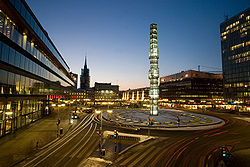
Public Square
Public Square is the central plaza in downtown Cleveland, Ohio, United States. It takes up four city blocks; Superior Avenue and Ontario Street cross through it. Cleveland's three tallest buildings, Key Tower, 200 Public Square and the Terminal Tower, face the square...
in Stockholm
Stockholm
Stockholm is the capital and the largest city of Sweden and constitutes the most populated urban area in Scandinavia. Stockholm is the most populous city in Sweden, with a population of 851,155 in the municipality , 1.37 million in the urban area , and around 2.1 million in the metropolitan area...
, Sweden
Sweden
Sweden , officially the Kingdom of Sweden , is a Nordic country on the Scandinavian Peninsula in Northern Europe. Sweden borders with Norway and Finland and is connected to Denmark by a bridge-tunnel across the Öresund....
, named after 18th century sculptor Johan Tobias Sergel
Johan Tobias Sergel
Johan Tobias Sergel , Swedish sculptor, was born in Stockholm.-Biography:After studying for some time in Paris he went to Rome, where he remained for twelve years and sculpted a number of groups in marble, including, besides subjects from classical mythology, a colossal representation of "History,"...
, whose workshop was once located north of the square.
Overview
Sergels torg has a dominant west-to-east axis and is divided into three distinct parts.- A sunken pedestrian plaza furnished with a triangular pattern (colloquially referred to as Plattan, "The Slab") and a wide flight of stairs leading up to the pedestrian street Drottninggatan, connecting south to Stockholm Old TownGamla stanGamla stan , until 1980 officially Staden mellan broarna , is the old town of Stockholm, Sweden. Gamla stan consists primarily of the island Stadsholmen. The surrounding islets Riddarholmen, Helgeandsholmen, and Strömsborg are officially part of, but not colloquially included in, Gamla stan...
and north to KungsgatanKungsgatan, StockholmKungsgatan is a street in central Stockholm.At its western end it is connected to Kungsholmen by Kungsbron bridge, from where it stretches east to Stureplan public square. It is intercepted by the streets Vasagatan, Drottninggatan, and Sveavägen...
. - This plaza is partly overbuilt by a roundabout centred on a glass obelisk and by the concrete decks of three major streets.
- North of this traffic junction is a considerably smaller open space overlooked by the high-rise façade of the fifth Hötorget BuildingHötorget buildingsThe Hötorget buildings are five high-rise office buildings in Stockholm, Sweden. Located between the squares Hötorget and Sergels Torg in the central Norrmalm district, they stand 72 meters tall and are a clearly visible landmark....
from where the avenue SveavägenSveavägenSveavägen is a major street in Stockholm, Sweden. The street starts at Sergels torg in the city center and goes north out of the city towards the Haga Park. It is often known as the busiest road in Sweden....
extends north.
The site south of the square is taken up by the cultural centre Kulturhuset
Kulturhuset
Opened in 1974, Kulturhuset is a cultural centre to the south of Sergels Torg in central Stockholm. It is a controversial symbol for Stockholm and the growth of modernism in Sweden...
, which also harbours the Stockholm City Theatre
Stockholm City Theatre
Stockholm City Theatre is Sweden's most popular theatre stage. It was created in 1956 but the first performance was delayed until 1960. It had not yet been decided at that point where in the city the theatre would lie so the Folkets hus building at Norra Bantorget, with a temporary stage, became...
and hides the Bank of Sweden headquarters facing the square Brunkebergstorg behind. Klarabergsgatan leads west past the department store Åhléns City
Åhléns
Åhléns is a Swedish chain of department stores, located in almost every city in the country, and with several stores in the major cities, including 18 stores in Stockholm alone . Åhléns also has business operations in Norway. It is one of Sweden’s leading retailers in a number of fields...
and Klara Church
Klara Church
The Church of Saint Clare or Klara Church is a church in central Stockholm.The Church of Saint Clare is located on Klara Västra Kyrkogata in the Klara area in lower Norrmalm. The graveyard, which has had the same location since the 17th century, is almost completely surrounded by modern...
to Klarabergsviadukten
Klarabergsviadukten
Klarabergsviadukten is a reinforced concrete bridge and a viaduct in central Stockholm, Sweden. Stretching over Klara Sjö, it connects Norrmalm to Kungsholmen....
and Kungsholmen
Kungsholmen
Kungsholmen is an island in Lake Mälaren in Sweden, part of Stockholm City. It is situated north of Riddarfjärden and considered part of the historical province Uppland....
. Hamngatan
Hamngatan
Hamngatan is a street in central Stockholm. It goes from Sergels torg down to Nybroplan, past NK department store, Kungsträdgården, Norrmalmstorg, and Berzelii Park. The Djurgården line travels along this street between Nybroplan and Norrmalmstorg....
leads east under Malmskillnadsgatan
Malmskillnadsgatan
Malmskillnadsgatan is a 650 metres long street in central Stockholm, Sweden. It stretches northward from the Brunkebergstorg square over Hamngatan; crosses Mäster Samuelsgatan and Oxtorgsgatan; passes over the bridge Malmskillnadsbron passing over Kungsgatan; crosses Brunnsgatan and David Bagares...
to Kungsträdgården
Kungsträdgården
Kungsträdgården is a park in central Stockholm, Sweden. It is colloquially known as Kungsan.The park's central location and its outdoor cafés makes it one of the most popular hangouts and meeting places in Stockholm. It also hosts open-air concerts and events in summer, while offering an ice...
, Norrmalmstorg
Norrmalmstorg
Norrmalmstorg is a square in central Stockholm. The square connects shopping streets Hamngatan and Biblioteksgatan and is the starting point for tram travellers with the Djurgården line...
, and Strandvägen
Strandvägen
Strandvägen is a boulevard on Östermalm in central Stockholm, Sweden. Completed just in time for the Stockholm World's Fair 1897, it quickly became known as one of the most prestigious addresses in town....
. Together with the underground mall east of the pedestrian plaza and the T-Centralen
T-Centralen
T-Centralen is a metro station that forms the heart of the Stockholm Metro system, in the sense that it is the only station where all three of the system's lines meet...
metro station and other continuous underpasses west thereof, Sergels torg forms part of a continuous underground structure almost a kilometre in length.
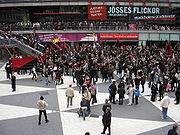
Centre Georges Pompidou
Centre Georges Pompidou is a complex in the Beaubourg area of the 4th arrondissement of Paris, near Les Halles, rue Montorgueil and the Marais...
in Paris
Paris
Paris is the capital and largest city in France, situated on the river Seine, in northern France, at the heart of the Île-de-France region...
and much like its French counterpart remains the most popular space in Stockholm for meeting friends, for political demonstrations, for a wide range of events, and for drug-dealers. This includes the fountain, in which people celebrate every major victory by a Swedish sports team.
History

Early proposals
Albert Lilienberg was appointed city-planning superintendent in 1927, and a year later he produced the first proposal for a public square on the location in his general planGeneral plan
A general plan is the policy of acceptable land uses in each jurisdiction. Each city and county adopts and updates their General Plan to guide the growth and land development of their community, for both the current period and the long term...
of 1928. In his proposal he envisioned a square whose north-south oriented axis would line-up with Sveavägen intended to be extended south across the square down to the waterfront with widened Hamngatan
Hamngatan
Hamngatan is a street in central Stockholm. It goes from Sergels torg down to Nybroplan, past NK department store, Kungsträdgården, Norrmalmstorg, and Berzelii Park. The Djurgården line travels along this street between Nybroplan and Norrmalmstorg....
and Klarabergsgatan joining in from west and east. After this first proposal, the square is featured on every subsequent city plan produced for the area, with alternations in width and length. Notwithstanding the considerable number of revised proposals produced, surprisingly few were preoccupied by architectonic considerations, instead focusing on optimization of traffic flow.
In the city plan Helldén produced in 1946, the square, still named Sveaplatsen ("Svea
Svea
Svea is a Swedish female name. The name was a very popular girls' name during the first half of the 20th century. It may also refer to:*Mother Svea, the Swedish national emblem.*Svea, Svalbard, a mining settlement*Svea, Florida*Svea, Minnesota...
Plaza"), was conceived as similar to the present square, but still remained an unarticulated modernistic concept. In this proposal, the square was centred on a rectangular open space furnished with trees, benches, and ponds; a space reached by subways stretching under the surrounding roundabout. During the 1950s, continuously increasing traffic loads made separating pedestrians and car traffic desirable, and several studies produced around 1955 focused on a lower level for pedestrians with cars on street-level with various openings to allow light down to the pedestrians.
Final proposal
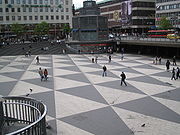
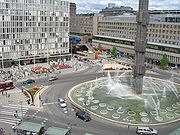
Coventry
Coventry is a city and metropolitan borough in the county of West Midlands in England. Coventry is the 9th largest city in England and the 11th largest in the United Kingdom. It is also the second largest city in the English Midlands, after Birmingham, with a population of 300,848, although...
and London
London
London is the capital city of :England and the :United Kingdom, the largest metropolitan area in the United Kingdom, and the largest urban zone in the European Union by most measures. Located on the River Thames, London has been a major settlement for two millennia, its history going back to its...
, to find a better solution. In Stuttgart
Stuttgart
Stuttgart is the capital of the state of Baden-Württemberg in southern Germany. The sixth-largest city in Germany, Stuttgart has a population of 600,038 while the metropolitan area has a population of 5.3 million ....
they could conclude that having pedestrians on a lower level required escalators, and in Vienna
Vienna
Vienna is the capital and largest city of the Republic of Austria and one of the nine states of Austria. Vienna is Austria's primary city, with a population of about 1.723 million , and is by far the largest city in Austria, as well as its cultural, economic, and political centre...
the pedestrians hall Opernpassage gave them the inspiration to replace the central open space at Sveaplatsen with a round restaurant with glass walls, an aesthetic device intended to give the square an architectonic dignity.
This newly introduced centre-piece resulted in a proposal for a fountain with a monument above it. For the shape of this fountain, Helldén consulted his friend, the mathematician and artist Piet Hein
Piet Hein (Denmark)
Piet Hein was a Danish scientist, mathematician, inventor, designer, author, and poet, often writing under the Old Norse pseudonym "Kumbel" meaning "tombstone"...
, who in less than in minute found a curve with a "continuously varying bending" and immediately named it the superellipse
Superellipse
A superellipse is a geometric figure defined in the Cartesian coordinate system as the set of all points withwhere n, a and b are positive numbers....
. Before presenting his final proposal in 1960, Helldén added the triangular pattern to the pedestrian plaza and the wide stairs on its western side.
A contest for the central monument in 1962 was won by Edvin Öhrström
Edvin Öhrström
Karl Edvin Öhrström was a Swedish sculptor and glass artist.Öhrström grew up in Halmstad, where his father worked at the railroad...
, with the 37 metre tall glass obelisk which was named Kristall - vertikal accent i glas och stål ("Crystal - vertical accent in glass and steel"). The sculpture, finally completed in 1974 and since haunted by technical problems, never was able to deliver the intended visual output and - quoting Hall - "thus adds itself to the many projects within the [reconstruction of central Stockholm] that didn't endure confrontation with reality." The artist favoured by Helldén, Olle Baertling, started to work on a sculpture for the square in 1960 but never was invited to participate in the contest.
Kulturhuset
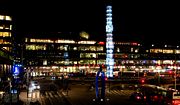
Pontus Hultén
Karl Gunnar Vougt Pontus Hultén was a Swedish art collector and museum director. Pontus Hultén is regarded as one of the most distinguished museum professionals of the twentieth century...
, the legendary founder of Moderna Museet
Moderna Museet
Moderna museet, the Museum of Modern Art, Stockholm, Sweden, is a state museum located on the island of Skeppsholmen in central Stockholm, that was first opened in 1958. Its first manager was Pontus Hultén...
who wished to see his museum relocated from the isolated island Skeppsholmen
Skeppsholmen
Skeppsholmen is one of the islands of Stockholm. It is connected with Blasieholmen and Kastellholmen by bridges. Positioned strategically at the Baltic Sea entrance to Stockholm, it has traditionally been the location of several military buildings...
. The contest was won by architect Peter Celsing
Peter Celsing
Peter Celsing was a Swedish modernist architect.Celsing studied at the architectural school of the Royal Institute of Technology in Stockholm, and at the Royal Swedish Academy of Arts. He later became professor of architecture at the Royal Institute of Technology...
and Kulturhuset
Kulturhuset
Opened in 1974, Kulturhuset is a cultural centre to the south of Sergels Torg in central Stockholm. It is a controversial symbol for Stockholm and the growth of modernism in Sweden...
was eventually inaugurated in 1974. It basically is a single huge concrete wall from which are consoling shallow stories with glassed façades, a structure Hultén lyrically described as a stage which would "exercise a strong attractive force" by exhibiting people and works of art through the glass façade.
However, considering Stockholm's northern location, to give the sun full access to public spaces is top priority, and Kulturhuset has proven a problematic wall which not only shuts the sun off, but also tends to dominate the square with its large volume. Additionally, Sergels torg is dominated by its traffic roundabout and is hard to experience as a single coherent space. Together with the traffic structure at Slussen
Slussen
Slussen is an area of central Stockholm, connecting Södermalm and Gamla stan. The area is named after the locks between Lake Mälaren and the Baltic Sea. The locks themselves allow passage between these two bodies of water...
, built in the 1930s, Sergels torg is thus an attempt with few parallels in the world, to make public art of a traffic junction dominating the central district of a city. Since the mid 1990s, countless proposals to rebuild the square has been produced, and the debate regarding the square is likely to continue.
See also
- HötorgetHötorgetHötorget is a city square in the center of Stockholm. During the daytime it is the site of a fruit and vegetable market, except on Sundays, when flea markets are arranged....
- Norrmalm
- History of StockholmHistory of StockholmThe history of Stockholm, capital of Sweden, for many centuries coincided with the development of what is today known as Gamla stan, the Stockholm Old Town...
- Redevelopment of NorrmalmRedevelopment of NorrmalmThe redevelopment of Norrmalm was a major revision of the city plan for lower Norrmalm in Stockholm, Sweden, which was realised during the 1950s, 1960s, and 1970s. The renewal resulted in the old Klara quarters being replaced for the modern city of Stockholm, according to rigorist CBD ideas, while...

